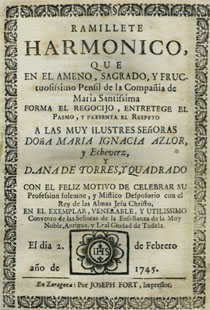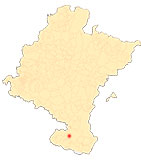The Church of the Company of Mary (Tudela)
By Ricardo Fernández Gracia
Feast and sacred oratory
The rhetorical and theatrical resources in the sermons were in tune with the images. The latter were very frequent acts and the preachers took great care of what they said in the pulpit, preparing ad hoc panegyrics, according to the audience, with the corresponding ornatus full of the prevailing rhetoric and always with the triple content of teaching, delighting and moving behaviors. The preacher was required to pray, study, as well as to excite fervor, displaying science, eloquence and wit. All this in order to achieve the three aforementioned purposes of sacred oratory, which was none other than the movere, or to mark behaviors, not only by delighting and teaching, but also by moving the affections in the hearts.
The temple was blessed by the treasurer of the collegiate church of Tudela, Don Félix de Aperregui, brother of the nun Doña Petronila de Aperregui, whom we have referred to above. There was no lack of city authorities, music of all kinds, the ringing of bells, the procession with the Blessed Sacrament, as well as "public rejoicings, fires and bonfires to the use of the country". But these were not the major festivities that the temple knew, since the sermons, carols and celebrations were like never before in the high school and in the city, on the occasion of the taking of the habit and profession of María Ignacia de Azlor and her cousin back in 1743 and 1745.
-
PUIG Y ARBELOA, M. C., review histórica de la fundación del convento de religiosas de la Compañía de María y teaching de Tudela, Madrid, Imprenta a position de D. R. P. Infante, 1876.
-
FOZ Y FOZ, M. P., La revolución pedagógica en Nueva España 1754-1820 (María Ignacia de Azlor y Echeverz y los colegios de la teaching), Madrid, high school Gonzalo Fernández de Oviedo, 1981.
-
ECHEVERRÍA GOÑI, P., and FERNÁNDEZ GRACIA, R., "La arquitectura religiosa de los siglos XVI al XVIII en Navarra", Ibaiak eta Haranak. guide del Patrimonio artístico y paisajístico. Navarra, vol. VIII, San Sebastián, Etor, 1991.
-
AZANZA LÓPEZ, J. J., Arquitectura Religiosa Barroca en Navarra, Pamplona, Government of Navarre, 1996.
-
FERNÁNDEZ GRACIA, R., The Baroque altarpiece in Navarre. Pamplona, Government of Navarre, 2003.
-
CARRASCO NAVARRO, C., Los palacios barrocos de Tudela. Arquitectura y Nobleza, Tudela, Castel Ruiz- M. I. Ayuntamiento de Tudela, 2014.












